For the 2025 school year, there are 3 public elementary schools serving 1,080 students in Junction City SD 69 School District. This district's average elementary testing ranking is 5/10, which is in the bottom 50% of public elementary schools in Oregon.
Public Elementary Schools in Junction City SD 69 School District have an average math proficiency score of 25% (versus the Oregon public elementary school average of 32%), and reading proficiency score of 43% (versus the 44% statewide average).
Minority enrollment is 25% of the student body (majority Hispanic), which is less than the Oregon public elementary school average of 41% (majority Hispanic).
Overview
This School District
This State (OR)
# Schools
4 Schools
1,027 Schools
# Students
1,597 Students
367,441 Students
# Teachers
94 Teachers
20,839 Teachers
Student : Teacher Ratio
17:1
17:1
District Rank
Junction City SD 69 School District, which is ranked within the bottom 50% of all 186 school districts in Oregon (based off of combined math and reading proficiency testing data) for the 2021-2022 school year.
The school district's graduation rate of 75-79% has decreased from 80-84% over five school years.
Overall District Rank
#101 out of 189 school districts
(Bottom 50%)
(Bottom 50%)
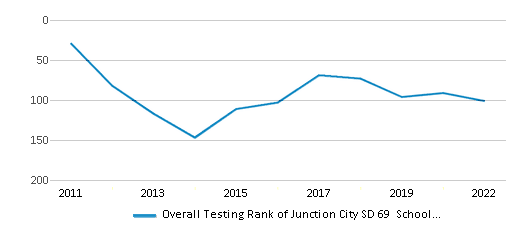
Math Test Scores (% Proficient)
24%
31%
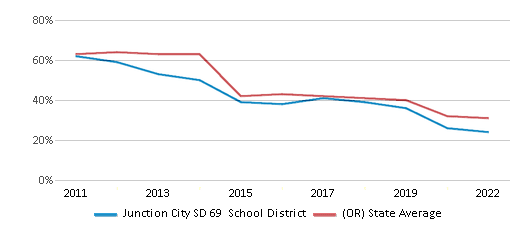
Reading/Language Arts Test Scores (% Proficient)
43%
44%
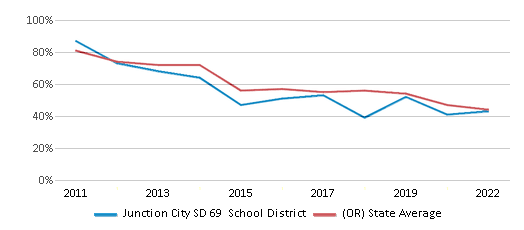
Science Test Scores (% Proficient)
32%
30%

Graduation Rate
75-79%
81%

Students by Ethnicity:
Diversity Score
0.42
0.59
# American Indian Students
23 Students
3,950 Students
% American Indian Students
1%
1%
# Asian Students
9 Students
14,976 Students
% Asian Students
1%
4%
# Hispanic Students
270 Students
92,275 Students
% Hispanic Students
17%
25%
# Black Students
20 Students
8,831 Students
% Black Students
1%
2%
# White Students
1,189 Students
215,165 Students
% White Students
75%
59%
# Hawaiian Students
8 Students
3,290 Students
% Hawaiian Students
1%
1%
# Two or more races Students
70 Students
27,772 Students
% of Two or more races Students
4%
8%
Students by Grade:
# Students in PK Grade:
-
-
# Students in K Grade:
108
35,045
# Students in 1st Grade:
133
38,201
# Students in 2nd Grade:
126
40,364
# Students in 3rd Grade:
121
39,761
# Students in 4th Grade:
121
41,356
# Students in 5th Grade:
104
41,259
# Students in 6th Grade:
107
41,436
# Students in 7th Grade:
135
36,830
# Students in 8th Grade:
125
37,438
# Students in 9th Grade:
131
3,418
# Students in 10th Grade:
143
3,820
# Students in 11th Grade:
139
4,067
# Students in 12th Grade:
104
4,446
# Ungraded Students:
-
-
District Revenue and Spending
The revenue/student of $15,904 in this school district is less than the state median of $18,279. The school district revenue/student has stayed relatively flat over four school years.
The school district's spending/student of $14,960 is less than the state median of $19,325. The school district spending/student has stayed relatively flat over four school years.
Total Revenue
$25 MM
$9,902 MM
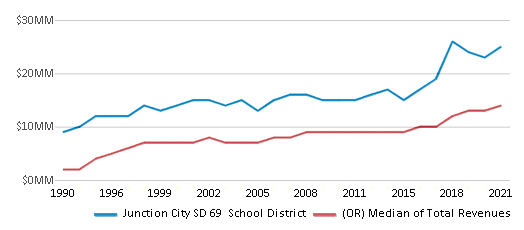
Spending
$24 MM
$10,468 MM
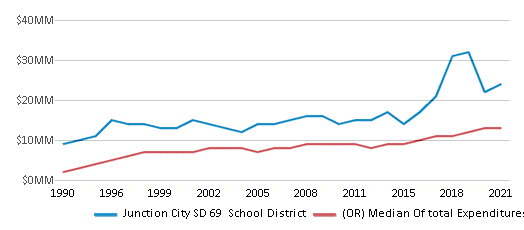
Revenue / Student
$15,904
$18,279
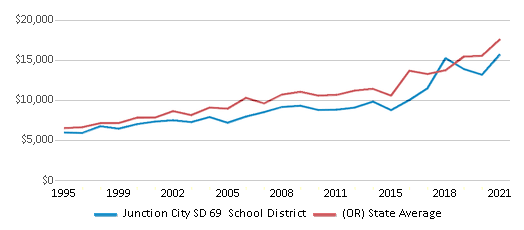
Spending / Student
$14,960
$19,325
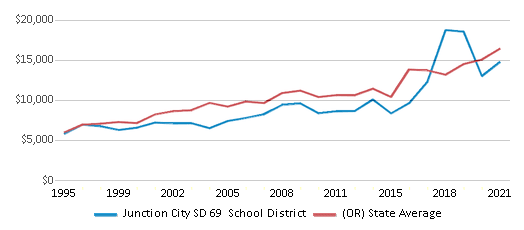
Best Junction City SD 69 School District Public Elementary Schools (2025)
School
(Math and Reading Proficiency)
(Math and Reading Proficiency)
Location
Grades
Students
Rank: #11.
Territorial Elementary School
(Math: 40-44% | Reading: 50-59%)
Rank:
Rank:
8/
Top 30%10
92609 Territorial Rd
Junction City, OR 97448
(541) 998-8371
Junction City, OR 97448
(541) 998-8371
Grades: K-5
| 136 students
Rank: #22.
Laurel Elementary School
(Math: 30-34% | Reading: 30-34%)
Rank:
Rank:
5/
Bottom 50%10
1401 Laurel St
Junction City, OR 97448
(541) 998-2386
Junction City, OR 97448
(541) 998-2386
Grades: K-4
| 496 students
Rank: #33.
Oaklea Middle School
(Math: 20% | Reading: 46%)
Rank:
Rank:
4/
Bottom 50%10
1515 Rose St
Junction City, OR 97448
(541) 998-3381
Junction City, OR 97448
(541) 998-3381
Grades: 5-8
| 448 students
Recent Articles

What Is A Charter School?
Explore the world of charter schools in this comprehensive guide. Learn about their history, how they operate, and the pros and cons of this educational innovation. Discover key facts about charter schools, including admission policies, demographics, and funding, as well as what to look for when considering a charter school for your child.

10 Reasons Why High School Sports Benefit Students
Discover the 10 compelling reasons why high school sports are beneficial for students. This comprehensive article explores how athletics enhance academic performance, foster personal growth, and develop crucial life skills. From improved fitness and time management to leadership development and community representation, learn why participating in high school sports can be a game-changer for students' overall success and well-being.

February 05, 2025
Understanding the U.S. Department of Education: Structure, Impact, and EvolutionWe explore how the Department of Education shapes American education, from its cabinet-level leadership to its impact on millions of students, written for general audiences seeking clarity on this vital institution.





